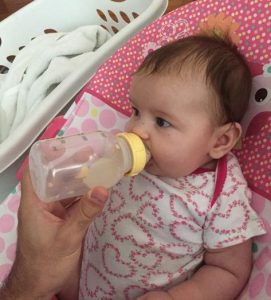For new parents, feeding their baby is a top priority. There are two main ways to nourish your little one: breastfeeding and bottle feeding. This article will explore the benefits of both methods, and discuss factors to consider when deciding when to start bottle feeding.
Important Note: The American Academy of Pediatrics (AAP) recommends exclusive breastfeeding for the first 6 months of life, followed by continued breastfeeding along with complementary foods for at least 1 year. This article is for informational purposes only and should not be misconstrued as medical advice. Always consult with your pediatrician to determine the best feeding plan for your baby.
The Benefits of Breastfeeding
Breast milk is widely recognized as the optimal source of nutrition for newborns and infants. Here are some of the benefits of breastfeeding:
Provides essential nutrients:
Breast milk is perfectly designed to meet a baby’s nutritional needs in the first months of life. It’s packed with vitamins, minerals, and antibodies that help protect your baby from illness.
Promotes bonding:
Breastfeeding creates a close and intimate connection between parent and baby. Skin-to-skin contact during breastfeeding releases oxytocin, a hormone that promotes bonding and feelings of love.
May offer health benefits:
Breastfeeding has been linked to a number of health benefits for both babies and mothers. Babies who are breastfed may have a lower risk of ear infections, respiratory illnesses, and diarrhea. Mothers who breastfeed may have a lower risk of breast and ovarian cancer.

The Benefits of Bottle Feeding
Bottle feeding can be a wonderful way to nourish your baby and provide flexibility in feeding routines. Here are some of the benefits of bottle feeding:
-
Shared feeding responsibilities: Bottle feeding allows fathers, partners, grandparents, or caregivers to share feeding duties and create special bonding moments with the baby.
-
Dietary restrictions: If you have a dietary restriction or medical condition that prevents you from breastfeeding, bottle feeding ensures your baby receives the nutrients they need.
-
Supplemental feeding: Bottle feeding can be a helpful way to supplement breastfeeding if your baby needs extra calories or has difficulty latching.
-
Monitoring intake: Bottle feeding allows you to more easily track how much milk your baby is consuming at each feeding.

Deciding When to Start Bottle Feeding
The decision of when to start bottle feeding is a personal one. There’s no single “right” answer, and the best time will vary depending on your individual circumstances. Here are some factors to consider:
-
Your breastfeeding goals: Do you plan to exclusively breastfeed for the first 6 months? Are you open to combining breastfeeding and bottle feeding?
-
Your baby’s needs: Is your baby getting enough breast milk? Are they showing signs of hunger after breastfeeding?
-
Your lifestyle: Do you need to return to work or school soon? Do you have a partner or caregiver who can help with bottle feeding?
-
Medical considerations: If you have any medical conditions that may impact breastfeeding, talk to your doctor about whether bottle feeding is necessary.
Remember: It’s always best to consult with your pediatrician to discuss your individual situation and develop a feeding plan that’s right for you and your baby.

Tips for Introducing Bottle Feeding
If you decide to introduce bottle feeding, here are some tips for a smooth transition:
-
Start early: If you plan to combine breastfeeding and bottle feeding, it’s best to introduce the bottle early on, ideally before your baby is 4 weeks old. This helps them get accustomed to a nipple other than your breast.
-
Let someone else do the bottle feeding: At first, have someone other than the primary caregiver offer the bottle. This can help avoid nipple confusion.
-
Choose the right nipple: Select a nipple that mimics the feel and flow of your breast. Experiment with different nipple types to find one your baby likes.
-
Be patient: Introducing a bottle takes time and patience. Don’t get discouraged if your baby rejects the bottle at first. Keep trying and eventually they will get the hang of it.
The choice between breastfeeding and bottle feeding is a personal one. There is no right or wrong answer, and the most important thing is to find a feeding plan that works best for you and your baby. By considering the benefits of both methods, consulting with your pediatrician, and following these tips, you can make an informed decision about when to start bottle feeding and ensure your baby receives the nourishment they need to thrive.

Making an Informed Decision
There’s no one-size-fits-all answer to when to introduce bottle feeding. Here are some resources that can help you make an informed decision:
- The American Academy of Pediatrics (AAP) website has a wealth of information on breastfeeding and bottle feeding, including guidance on introducing bottle feeding: https://www.aap.org/en/patient-care/breastfeeding/
- La Leche League International is a nonprofit organization that provides support and information to breastfeeding mothers. Their website has a section on combining breastfeeding and bottle feeding: https://llli.org/
These resources can provide you with detailed information on the benefits of breastfeeding and bottle feeding, as well as factors to consider when introducing bottle feeding.
Remember: It’s always best to consult with a doctor or licensed lactation consultant to discuss your individual situation and develop a feeding plan that’s right for you and your baby.

Building a Support Network
Bottle feeding can be a smooth transition with the right support. Here are some resources that can help:
-
Lactation consultants: These healthcare professionals can provide guidance on breastfeeding and bottle feeding, including tips on introducing a bottle.
-
Support groups: Connecting with other parents who are bottle feeding can offer encouragement and helpful advice.
-
Friends and family: Having a network of people who can help with bottle feeding can make a big difference, especially if you return to work or school soon after childbirth.
Some babies take to bottle feeding quickly, while others may need more time to adjust. You’ll need bottles, nipples, formula (if not using breastmilk), bottle brushes, and a sterilizer (if using one). Be patient and try different approaches if needed. By planning ahead, gathering information, and building a support network, you can make bottle feeding a positive experience for you and your baby.
